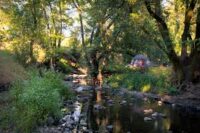With less than 10 days left of public comment – extended to Jan. 7 due to the holidays – and no forum scheduled for further discussion, the Sonoma Agricultural and Open Space District seems on course to pursue a public access plan for the Montini Open Space Preserve that, according to some, would make Solomon weep.
The ancient King Solomon settled an argument by offering to divide a disputed baby in half, knowing the true mother would not destroy her loved one in order to possess it. In September, the Open Space District, seeking to reconcile local land use needs with state law requirements, presented the Sonoma City Council with a similar decision. The proposed compromise, which the City Council rejected 4-1, would divide – some would say destroy –a local treasure, the cherished Montini cow pasture, that forms a backdrop to the history and visual identity of the city.
The dilemma for Sonoma is a classic one in terms of land use: How to preserve the essential qualities of a landscape while allowing for the public access – including handicapped access – which the Open Space District must provide.
“I like the idea that you can have your cake and eat it too,” said Bill Keene, assistant manager of the Sonoma Agricultural and Open Space District. “You can have grazing and recreation.” But achieving that balance has not been easy. Last fall, when it was unofficially suggested that cows might be excluded from the pasture in favor of the trail, a public outcry led to the effort at mediation.
Keene described the mediation process, paid for by the District, in which the City of Sonoma, landowner Bill Montini, representatives of the District and the neighborhood all came to the table to work out a compromise that would allow the people to be able to continue to see cows on the hillside, and the District to build a trail system to required standards. “The mediation called for a trail that crosses the old Montini property,” he said, “with fences on both sides, which protects the humans from the cows, the cows from the humans and the trail from the cows.”
The compromise, according to many, defeats a long-fought campaign for preservation. Larry Barnett, former mayor and city councilman, said that for seven of the 12 years he was on the city council he helped to facilitate negotiations of the 152 acres of Montini land, including the cow pasture. “I have an intimate understanding of how this [negotiation] started,” he said. “It was initiated to create two primary goals: 1) preservation of the backdrop of the hillside to protect it from development; 2) preservation of the cow pasture. It was an articulated and primary goal.”
What has happened now, in his view, and in that of former landowner Bill Montini, is that the cow pasture, as planned, by being graded, fenced and developed as a system of trails, will no longer have the character Montini and others have sought to protect.
“My family has been on the property since 1916, and bought the property in 1934,” said Montini. “Now the Open Space District is going to turn this into a park,” he said. “It’s going to be a construction site. Moving hundreds of yards of dirt. How does this fit into presentation?” He made it clear that having people enjoying the place was not his concern; it was the re-configuring of the landscape that he objected to, instead of preserving it as it was. “I’ve got no complaints about people walking on the property, but it needs to be done in a manner that allows people to walk on the property without having to reconstruct the whole hill,” he said. As for roads, he said there are plenty of service roads and natural paths on the place. “There’s over a mile of roads already existing on this property. There are numerous cow trails and deer trails. They could use those by trimming the bushes and it’s a done deal. The field could be left the way it was. You could get emergency vehicles up there, access for fire trucks. Something simple, basic and adequate.” That was what he’d intended. The current plan makes him sad. “This stuff is a science project for the Open Space district.”
Sonoma City Councilmember Steve Barbose, who participated in the mediation process as the city council’s designated representative, expressed frustration that the council had rejected the compromise. “I thought we struck a very good compromise,” he said, “in that we had cows in half the field. People would still see cows in the northern section of the property.” To those who treasure the whole view, half a field, as a compromise, is not viable.
“I just feel bad,” said Keene. “I feel bad for the district. The district spent $14 million to buy the property and get people out there, and then we have to deal with something ugly. It’s very disappointing for me.” Barbose agreed, “It’s not a successful ending to this partnership. I’m disappointed.”
Sonoma City Councilmember August Sebastiani said, “I think there’s a bigger picture here. It’s relative to the business of being on the city council. On most issues, we all want what’s best for Sonoma, but we all may have different visions about how to get there.”
City Planner David Goodison said staff had hoped the mediation process would result in a plan everyone would accept, but that now, it’s up to the Open Space district. “Our work is now done.”
“We have to go to our board for approval of the project,” said Keene, “The public review period is nearly over. We’ve got to go to our board and my hope is that we’ll have approval of that in the near future.” He added, “I think you’d be surprised if Joe Sonoma didn’t want access to that hillside. We need places in areas like Sonoma for children and families to go to connect them to nature. And Montini is one of those places.”
Montini land plan disappoints all around
More from NewsMore posts in News »




